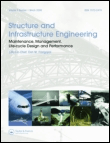
Structure and Infrastructure Engineering
metrics 2024
Transforming Challenges into Engineering Triumphs
Introduction
Structure and Infrastructure Engineering, published by TAYLOR & FRANCIS LTD, is a premier academic journal that serves as a vital resource in the fields of engineering and construction. Featuring an ISSN of 1573-2479 and an E-ISSN of 1744-8980, this journal has established its reputation as a leader in disseminating high-quality research. Since its inception, it has successfully transitioned through converged years from 2007 to 2024, earning a prestigious position within the Q1 quartile across multiple engineering disciplines, including Building and Construction, Civil and Structural Engineering, and Ocean Engineering, among others. Its impact is underscored by impressive Scopus rankings, particularly its 5th rank in Ocean Engineering within the top 95th percentile. The journal’s commitment to advancing knowledge in safety, risk, reliability, and quality makes it an indispensable platform for researchers, professionals, and students aiming to stay at the forefront of engineering innovations. Access to its comprehensive articles allows for a deeper understanding of contemporary challenges and solutions in infrastructure development.
Metrics 2024
 1.00
1.00 2.60
2.60 3.70
3.70 71
71Metrics History
Rank 2024
Scopus
IF (Web Of Science)
JCI (Web Of Science)
Quartile History
Similar Journals

Journal of Civil Structural Health Monitoring
Exploring the future of infrastructure monitoring and safety.The Journal of Civil Structural Health Monitoring, published by SPRINGER HEIDELBERG, is a premier academic journal dedicated to advancing the field of civil and structural engineering, with a specific focus on the health monitoring of infrastructure systems. With an ISSN of 2190-5452 and an E-ISSN of 2190-5479, the journal has established itself as a leading source of rigorous research, evidenced by its impressive Q1 rankings in both Civil and Structural Engineering and Safety, Risk, Reliability, and Quality categories for 2023. As a widely respected platform, the journal offers researchers and practitioners access to high-impact studies, innovative technologies, and insights into the ongoing efforts to enhance infrastructure resilience. Despite its lack of an open-access model, the journal's content is accessible through institutional libraries, ensuring that a wide audience of engineers and scientists can benefit from the latest advancements. With its converged years from 2011 to 2024, the journal continues to play a vital role in shaping best practices and policy decisions in civil engineering, making it an invaluable resource for professionals, scholars, and students alike.

Earthquakes and Structures
Building a safer future with cutting-edge earthquake engineering.Earthquakes and Structures is a prestigious academic journal published by TECHNO-PRESS, dedicated to the field of Civil and Structural Engineering. Since its inception in 2010, this journal has provided a platform for innovative research and practical applications, addressing critical challenges related to seismic activities and their impact on infrastructure. With an ISSN of 2092-7614 and an E-ISSN of 2092-7622, it is indexed in top databases, reflecting its commitment to quality and relevance, as indicated by its Q3 quartile ranking in 2023. The journal encompasses a wide range of topics, from theoretical investigations to real-world case studies, appealing to researchers, professionals, and students alike. By fostering interdisciplinary collaboration and disseminating cutting-edge findings, Earthquakes and Structures plays an essential role in advancing knowledge and practices in earthquake engineering, enhancing global resilience against seismic threats.

Infrastructures
Connecting Scholars and Professionals in Engineering ExcellenceInfrastructures is a distinguished open-access journal, published by MDPI since 2016, dedicated to advancing the fields of engineering and construction through interdisciplinary research and critical insights. Based in Switzerland, it serves a global community of scholars and professionals, providing a platform for innovative studies that drive progress in Building and Construction, Civil and Structural Engineering, Computer Science Applications, Geotechnical Engineering and Engineering Geology, and various aspects of Materials Science. With an impressive impact factor and a positioning in the Q2 category across multiple engineering fields, the journal's robust ranking reflects its commitment to high-quality research, with notable Scopus rankings showcasing its significant contribution to academic discourse. Infrastructures not only facilitates open access to essential knowledge but also aims to bridge the gap between theory and practical application, making it an invaluable resource for researchers, industry professionals, and students alike.
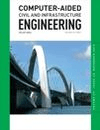
COMPUTER-AIDED CIVIL AND INFRASTRUCTURE ENGINEERING
Pioneering New Frontiers in Civil and Structural EngineeringCOMPUTER-AIDED CIVIL AND INFRASTRUCTURE ENGINEERING, published by WILEY, stands as a leading journal in the domains of civil and structural engineering, computational theory, and computer-aided design since its inception in 1986. With an impressive ISSN of 1093-9687 and E-ISSN of 1467-8667, this esteemed UK-based journal holds a prestigious position in the academic community, reflected by its Q1 ranking in numerous relevant categories, including Civil and Structural Engineering and Computer Graphics as of 2023. The journal is renowned for promoting innovative research that utilizes computational techniques to solve complex engineering problems, making it an essential resource for researchers, professionals, and students alike. Despite its lack of open access options, the journal garners significant interest due to its rigorous peer-review process and high-impact articles, underlining its importance in the advancement of infrastructure engineering practices and technologies. With a Scopus ranking placing it among the top journals in various engineering and computer science fields, COMPUTER-AIDED CIVIL AND INFRASTRUCTURE ENGINEERING continues to foster knowledge and collaboration, ultimately contributing to the future of smart and resilient infrastructure development.

Gradevinar
Pioneering Developments in Civil and Structural EngineeringGradevinar, published by the Croatian Society of Civil Engineers-HSGI, is a leading Open Access journal in the field of Civil and Structural Engineering, with a significant history that dates back to its inception in 1980. This journal, with the ISSN 0350-2465 and E-ISSN 1333-9095, has established itself as a vital platform for disseminating innovative research and practical developments in civil engineering, particularly since it became Open Access in 2000, facilitating unrestricted access to its wealth of knowledge. As of 2023, Gradevinar is ranked in the third quartile (Q3) of Scopus’s Civil and Structural Engineering category, demonstrating its growing influence and relevance in the academic community, with a current ranking of #255 out of 379 journals in the field. Researchers, professionals, and students benefit from this journal's commitment to high-quality content that reflects the latest advancements and best practices in civil engineering, contributing to both technical proficiency and sustainable development in infrastructure projects across Croatia and beyond.

Bulletin of the New Zealand Society for Earthquake Engineering
Transforming earthquake engineering with scholarly excellence.Bulletin of the New Zealand Society for Earthquake Engineering (ISSN: 1174-9857, E-ISSN: 2324-1543) is a leading scholarly journal published by the New Zealand Society for Earthquake Engineering, Inc., dedicated to advancing the field of earthquake engineering. Since its inception in 1970, the journal has provided a vital platform for the dissemination of innovative research, technical studies, and case reports related to civil and structural engineering, as well as geotechnical engineering and engineering geology. Recognized for its significant contributions, the journal holds a Q2 ranking in both the Civil and Structural Engineering and Geotechnical Engineering and Engineering Geology categories as of 2023. It serves as an invaluable resource for researchers, professionals, and students keen on enhancing their understanding of earthquake resilience and engineering practices. While the journal operates under subscription-based access, its rigorous peer-review process ensures that published articles meet the highest academic standards, making it a credible source for the global engineering community.
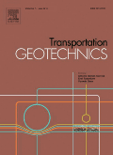
Transportation Geotechnics
Elevating Standards in Transportation Infrastructure.Transportation Geotechnics is a premier academic journal published by Elsevier, focusing on the intersection of geotechnical engineering and transportation systems. With an impressive impact factor and categorized in the Q1 quartile across multiple disciplines including Civil and Structural Engineering, Geotechnical Engineering, and Transportation, this journal stands as a vital resource for researchers and practitioners alike. It covers a broad spectrum of topics ranging from soil behavior in transport contexts to innovative materials and methods that enhance infrastructure stability and performance. As an essential platform fostering knowledge dissemination, Transportation Geotechnics enables contributors to share their groundbreaking findings while providing readers with access to cutting-edge research and reviews from 2014 to 2024. Its illustrious Scopus rankings place it prominently in the global research landscape, making it an indispensable tool for students, professionals, and academics dedicated to advancing the field.
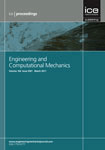
Proceedings of the Institution of Civil Engineers-Engineering and Computational Mechanics
Innovating Insights for Sustainable Infrastructure SolutionsProceedings of the Institution of Civil Engineers - Engineering and Computational Mechanics is a prestigious journal published by Emerald Group Publishing Ltd, dedicated to advancing the fields of civil and structural engineering, as well as mechanics of materials. With an ISSN of 1755-0777 and E-ISSN 1755-0785, this journal serves as a critical platform for disseminating innovative research and practical insights from 2009 through 2024. As part of its commitment to academic rigor, it is categorized in the Q4 quartile for both civil and structural engineering and mechanics of materials, reflecting a unique position in the scholarly community. The journal is essential for professionals, researchers, and students aiming to stay informed on current trends, methodologies, and applications in engineering and computational mechanics. By engaging with this publication, readers gain access to crucial findings that contribute to the advancement of infrastructure and materials science, vital for developing resilient and sustainable engineering solutions.

CANADIAN JOURNAL OF CIVIL ENGINEERING
Shaping Tomorrow's Infrastructure with Today’s DiscoveriesCanadian Journal of Civil Engineering, published by Canadian Science Publishing, serves as a premier platform for the dissemination of innovative research and development in the fields of civil and structural engineering, as well as environmental science. Established in 1971, this journal maintains a robust reputation, achieving a Q3 ranking in both civil engineering and general environmental science categories as of 2023. While it does not currently offer open access, the journal is accessible to a wide audience of researchers, professionals, and students who are keen to stay abreast of the latest advancements in civil engineering practices. With a significant number of yearly publications and a committed editorial board, the Canadian Journal of Civil Engineering contributes to the foundational knowledge and practical applications in the engineering community, thereby playing a critical role in addressing contemporary challenges in civil infrastructure and environmental sustainability.
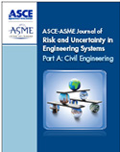
ASCE-ASME Journal of Risk and Uncertainty in Engineering Systems Part A-Civil Engineering
Fostering Innovation Amidst Engineering Challenges.ASCE-ASME Journal of Risk and Uncertainty in Engineering Systems Part A-Civil Engineering, published by the American Society of Civil Engineers (ASCE), is a leading journal dedicated to advancing the understanding and application of risk and uncertainty in civil engineering systems. With an ISSN of 2376-7642, this journal has been a pivotal platform for researchers and practitioners since its inception in 2015, converging its rigorous exploration through to 2024. It holds a commendable position in the academic community, securing a Q2 rating in categories such as Building and Construction, Civil and Structural Engineering, and Safety, Risk, Reliability and Quality as of 2023. The journal aims to disseminate innovative research that tackles the critical challenges posed by uncertainty in engineering systems, thus promoting safety, sustainability, and reliability in infrastructure. With impressive Scopus rankings, including a 76th percentile in Building and Construction, it continues to attract high-quality contributions from scholars worldwide. Emphasizing open dialogue, the journal does not currently adopt an open access model but remains committed to providing essential insights for the enhancement of civil engineering practices. Researchers, professionals, and students alike will find invaluable resources to enhance their knowledge and practice in this dynamic field.